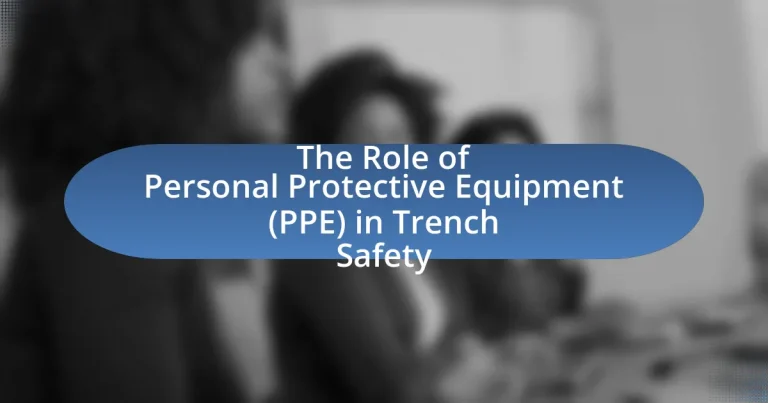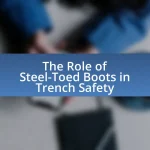Personal Protective Equipment (PPE) is essential for ensuring safety in trench environments, protecting workers from hazards such as cave-ins, falling objects, and exposure to hazardous materials. The article outlines the critical role of PPE, including hard hats, safety goggles, gloves, and steel-toed boots, in reducing the risk of injuries during trenching operations. It discusses the legal requirements set by the Occupational Safety and Health Administration (OSHA) for PPE usage, the importance of proper training and maintenance, and best practices for effective implementation. Additionally, the article highlights the challenges faced in PPE compliance and the significant impact of PPE on enhancing worker confidence and safety awareness in high-risk environments.
-in-Trench-Safety-1.webp)
What is the Role of Personal Protective Equipment (PPE) in Trench Safety?
Personal Protective Equipment (PPE) plays a critical role in trench safety by providing essential protection against hazards such as falling objects, exposure to hazardous materials, and potential trench collapses. PPE includes hard hats, safety goggles, gloves, and steel-toed boots, which collectively reduce the risk of injury in high-risk environments. According to the Occupational Safety and Health Administration (OSHA), proper use of PPE can significantly decrease the likelihood of accidents and injuries in trenching operations, emphasizing its importance in maintaining worker safety.
How does PPE contribute to safety in trench environments?
PPE significantly enhances safety in trench environments by providing essential protection against various hazards such as falling objects, exposure to hazardous materials, and potential trench collapses. For instance, hard hats protect against head injuries from falling debris, while high-visibility clothing ensures workers are easily seen, reducing the risk of accidents. Additionally, gloves and steel-toed boots safeguard against cuts and crush injuries. According to the Occupational Safety and Health Administration (OSHA), proper use of PPE can reduce the risk of injury in construction sites, including trenches, by up to 70%. This statistic underscores the critical role that PPE plays in mitigating risks associated with trench work.
What types of hazards does PPE protect against in trenches?
Personal Protective Equipment (PPE) protects against several hazards in trenches, including cave-ins, falling objects, hazardous materials, and exposure to environmental elements. Cave-ins are a primary risk in trench work, where the walls can collapse, posing a serious threat to workers. PPE such as helmets and harnesses mitigate the risk of injury from falling debris. Additionally, PPE like gloves and respirators safeguard against exposure to hazardous materials, including chemicals and contaminated soil. Lastly, protective clothing shields workers from environmental elements such as extreme temperatures and moisture, ensuring their safety and health while working in trenches.
How does PPE mitigate risks associated with trench work?
PPE mitigates risks associated with trench work by providing essential protection against hazards such as falling objects, exposure to hazardous materials, and potential trench collapses. For instance, hard hats protect workers from head injuries caused by falling debris, while high-visibility clothing ensures that workers are easily seen, reducing the risk of accidents. Additionally, gloves and steel-toed boots protect against cuts, punctures, and crush injuries. According to the Occupational Safety and Health Administration (OSHA), proper use of PPE can significantly reduce the likelihood of injury in high-risk environments like trenches, where the risk of cave-ins is particularly high.
Why is PPE essential for workers in trenching operations?
PPE is essential for workers in trenching operations to protect them from various hazards such as cave-ins, falling objects, and exposure to hazardous materials. Trenching operations often involve working in deep excavations where the risk of soil collapse is significant; according to the Occupational Safety and Health Administration (OSHA), trench collapses can occur within seconds, leading to serious injuries or fatalities. Additionally, PPE such as hard hats, gloves, and steel-toed boots provides crucial protection against falling debris and sharp objects, while high-visibility clothing enhances worker visibility in busy construction sites. The use of PPE is a critical component of safety protocols mandated by regulations to minimize risks and ensure worker safety in these high-risk environments.
What are the legal requirements for PPE in trench safety?
The legal requirements for personal protective equipment (PPE) in trench safety are outlined by the Occupational Safety and Health Administration (OSHA) regulations. Specifically, OSHA mandates that employers must provide appropriate PPE to workers in trenches that are deeper than five feet, where there is a potential for cave-ins, falling materials, or hazardous atmospheres. This includes hard hats, safety glasses, gloves, and steel-toed boots. Additionally, if workers are exposed to falling objects, employers must ensure that they wear head protection, and if there is a risk of exposure to hazardous materials, respiratory protection may also be required. Compliance with these regulations is essential to ensure worker safety and is enforced through inspections and penalties for non-compliance.
How does PPE enhance worker confidence and safety awareness?
Personal Protective Equipment (PPE) enhances worker confidence and safety awareness by providing physical protection against hazards, which reassures workers about their safety. When workers wear appropriate PPE, such as helmets, gloves, and high-visibility clothing, they feel more secure in their environment, leading to increased focus and productivity. Studies indicate that the use of PPE can reduce workplace injuries by up to 40%, reinforcing the importance of safety measures and fostering a culture of awareness among employees. This heightened sense of security encourages workers to engage in safe practices and communicate potential hazards, ultimately contributing to a safer work environment.
What are the different types of PPE used in trench safety?
The different types of PPE used in trench safety include hard hats, safety glasses, gloves, high-visibility clothing, and steel-toed boots. Hard hats protect against falling objects, while safety glasses shield the eyes from debris. Gloves provide hand protection from cuts and abrasions, and high-visibility clothing ensures workers are seen in low-light conditions. Steel-toed boots protect the feet from heavy equipment and falling materials. These PPE items are essential for minimizing risks associated with trench work, as they comply with OSHA regulations that mandate protective gear in hazardous environments.
What specific PPE items are recommended for trench work?
The specific PPE items recommended for trench work include hard hats, safety glasses, high-visibility vests, steel-toed boots, and gloves. Hard hats protect against falling objects, while safety glasses shield the eyes from debris. High-visibility vests ensure workers are easily seen, reducing the risk of accidents. Steel-toed boots provide foot protection from heavy materials, and gloves enhance grip and protect hands from cuts and abrasions. These items are essential for minimizing risks associated with trench work, as outlined by safety regulations and industry standards.
How do different PPE types address various trench hazards?
Different types of Personal Protective Equipment (PPE) address various trench hazards by providing specific protection against risks such as cave-ins, falling objects, and hazardous atmospheres. For instance, hard hats protect against head injuries from falling debris, while steel-toed boots prevent foot injuries from heavy equipment or materials. High-visibility vests enhance worker visibility in low-light conditions, reducing the risk of accidents. Additionally, respiratory protection is essential in trenches where toxic gases may be present, ensuring that workers can breathe safely. According to OSHA regulations, proper PPE is crucial in mitigating these hazards, emphasizing the importance of using the right equipment for specific risks encountered in trench work.
How can proper use of PPE improve trench safety?
Proper use of Personal Protective Equipment (PPE) significantly enhances trench safety by providing essential protection against various hazards encountered in trench work. PPE, such as hard hats, gloves, and high-visibility clothing, safeguards workers from falling objects, sharp edges, and visibility issues, which are common risks in trench environments. For instance, according to the Occupational Safety and Health Administration (OSHA), wearing hard hats can reduce the risk of head injuries by up to 70%. Additionally, the use of respiratory protection can prevent inhalation of harmful dust and gases, further ensuring worker safety. By adhering to PPE guidelines, workers can mitigate risks and enhance their overall safety while performing tasks in trenches.
What are the common challenges in implementing PPE in trench safety?
Common challenges in implementing PPE in trench safety include compliance with regulations, worker resistance, and inadequate training. Compliance issues arise when organizations fail to meet OSHA standards, which can lead to legal penalties and unsafe work environments. Worker resistance often stems from discomfort or perceived ineffectiveness of PPE, resulting in non-use. Inadequate training on proper PPE usage and maintenance can lead to improper use, diminishing the protective benefits. These challenges highlight the need for effective management strategies to ensure safety in trench operations.
How can training improve the effectiveness of PPE in trenches?
Training enhances the effectiveness of Personal Protective Equipment (PPE) in trenches by ensuring that workers understand proper usage, limitations, and maintenance of the equipment. When workers are trained, they learn how to correctly wear and adjust PPE, which maximizes its protective capabilities against hazards such as falling objects, exposure to harmful substances, and trench collapses. Studies indicate that effective training programs can reduce workplace injuries by up to 30%, demonstrating a clear link between training and improved safety outcomes. Additionally, training fosters a culture of safety awareness, encouraging workers to consistently use PPE and report any issues, further enhancing overall trench safety.
What are the best practices for maintaining PPE in trench environments?
The best practices for maintaining PPE in trench environments include regular inspection, proper cleaning, and appropriate storage. Regular inspection ensures that any damage or wear is identified early, which is crucial since PPE is designed to protect against specific hazards present in trench work, such as falling objects or exposure to chemicals. Cleaning PPE according to manufacturer guidelines prevents contamination and maintains its protective qualities; for instance, using mild detergents and avoiding harsh chemicals can prolong the life of materials. Proper storage in a dry, clean environment protects PPE from environmental damage and degradation, ensuring it remains effective when needed. These practices are supported by safety regulations, such as those outlined by the Occupational Safety and Health Administration (OSHA), which emphasize the importance of maintaining equipment to ensure worker safety in hazardous environments.
What are the key takeaways for ensuring effective PPE use in trench safety?
Key takeaways for ensuring effective PPE use in trench safety include proper selection, consistent training, and regular inspections. Proper selection involves choosing PPE that meets the specific hazards present in trench environments, such as hard hats for head protection, steel-toed boots for foot safety, and high-visibility clothing to enhance worker visibility. Consistent training ensures that all workers understand how to correctly wear and maintain their PPE, which is crucial for maximizing its protective capabilities. Regular inspections of PPE help identify wear and tear, ensuring that equipment remains effective and compliant with safety standards. According to the Occupational Safety and Health Administration (OSHA), proper PPE use can significantly reduce the risk of injuries in trenching operations, highlighting the importance of these key takeaways.

